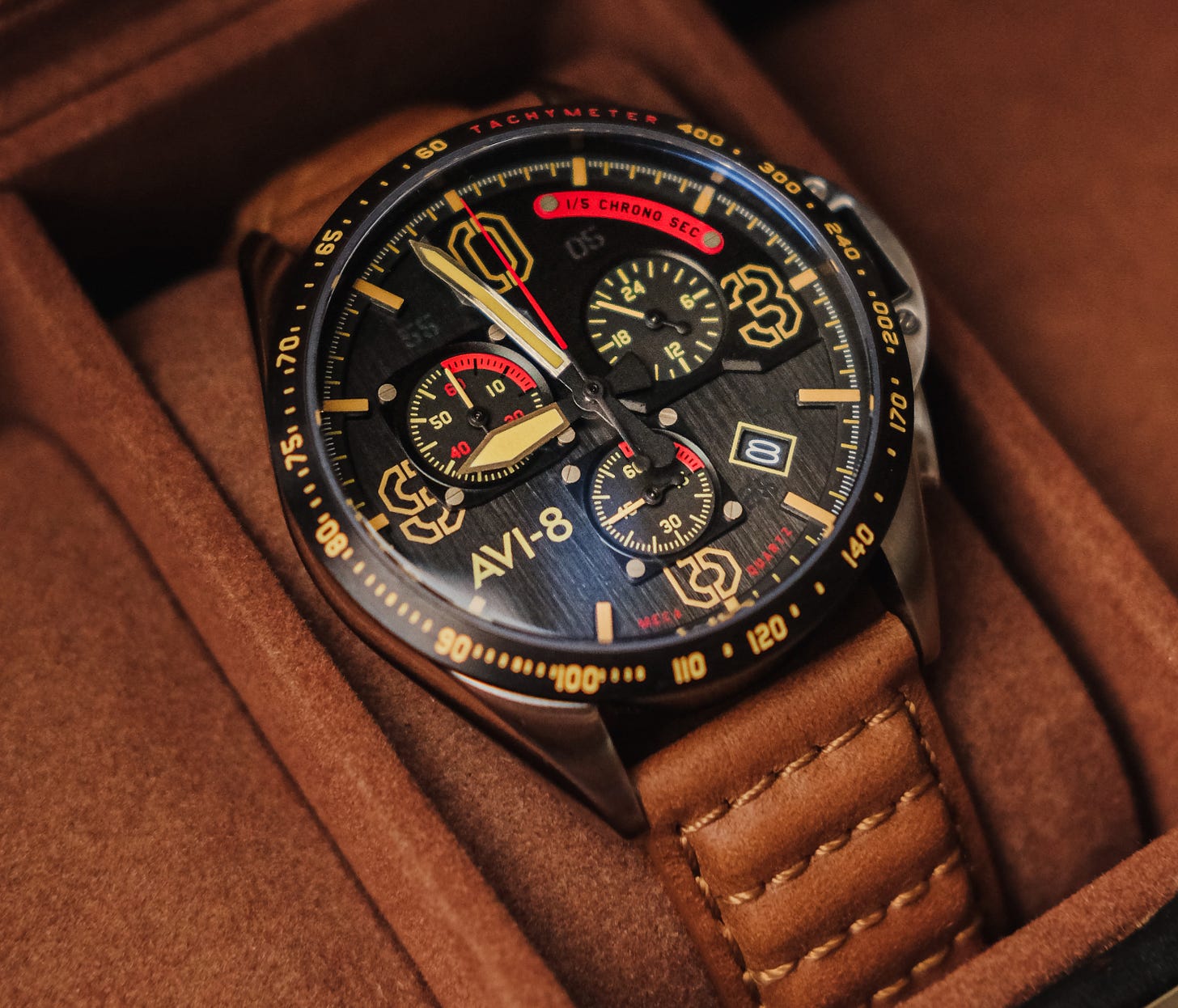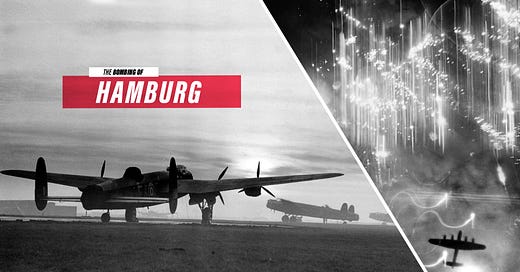The Battle of Hamburg (Operation Gomorrah)
In 1943, the heart of the German air defence system was the early-warning and flak-predictor radar systems. It had proved to be a good system, as was the British radar chain that had been set up since 1935. The Germans knew, however, that strips of metal foil could blind the radar sets and they were reluctant to use this against the enemy, lest the enemy employ the same strategy against them. Despite their hesitation, by mid-1943 the British had decided to put into play this strategy of using foil strips, or chaff, to blind the German radars. The system was called Window, and it would be used for the first time on July 24th, 1943, in a bombing raid over Hamburg, in what would become a devastating blow to this major German city. This would be Operation Gomorrah.

On the morning of July 24, 1943, Sir Arthur Harris issued executive orders for an attack on Hamburg and by 10:30 PM that evening British Pathfinder aircraft were setting out to rendezvous over Cromer and then onto Hamburg by 1am.
At nineteen minutes after midnight on the 25th, Air Danger alerts were sent out across Hamburg to hospitals, industry and government departments, and again five minutes later. Bomber formations were still far out to sea but the German early warning stations on the coast had picked them up. By thirty-three minutes past midnight the city’s air raid sirens burst into life.
Twenty Blind Marker aircraft of the Pathfinder force were leading the 791-strong force of bombers into Hamburg. The first of these, a Lancaster from Number 83 Pathfinder squadron, had already passed by the small island, Heligoland, at 12:28 AM and released a load of window to confuse the German radars. Navigating into Hamburg using their H2S radars, the Pathfinders were over Hamburg city by 12:50 AM and releasing their yellow target indicators and parachute flares. More Pathfinder aircraft followed up and identified actual aiming points and marked them with red ground-burning target indicators – dropping them from 4 miles above the target.
As more aircraft flew into the area heading toward Hamburg, more window was dropped and the accumulating clouds of foil in the air started to blind the German radar system and the flak batteries would have to fire blind. Observation of the incoming enemy bombers had to be by visual and sound identification only. The cathode-ray tubes of the radar stations were flickering and clouded by the released chaff and completely useless.
A few minutes before 1 AM the red target indicators had been dropped, some falling short, some a few miles off target to the south-east, the north-west, the north-east or the west. These were typical margins of error at the time.
The main force of 728 who claimed to have attacked, then paraded over the city dropping some 1,350 tons of high explosives. Among these bombs were hundreds of ‘blockbusters’ – large 4,000 pound bombs that were large drums filled with explosives. These blockbusters were concentrated in the early part of the attack to lay open buildings for the 932 tons of fire bombs to have maximum effect.
The night was very hot, low humidity, and had followed an unusually hot and dry July for Europe. There was a hot and dry breeze coming off the hot plains of western and central Germany. It was the ideal scenario for an incendiary attack on the city and the fires burned fiercely. The districts of Hoheluft, Elmsbüttel, Altona, and the inner city were devastated. Just after 3 AM the All Clear sounded. Fifteen hundred people were estimated killed.
The British had lost only 12 bombers out of the 791 dispatched on the mission. This was due to the enormous success of the window blinding German radar. It was clear that window worked and would, from this point on, be instrumental in effective bombing raids.
The German leadership were in a panic. There was a good chance the British would be back the following night, and they needed a strategy given the ineffectiveness of the radar system. The Luftwaffe commander, Reich Marshal Göring, asked Major Hajo Herrmann to put up some of his new Night Fighting Experimental Kommandos to intercept the night’s anticipated bombing attack. These fighters, dubbed ‘Wild Boar’ units, would not require guidance from radar ground stations but simply use the individual pilot’s vision and judgement during the interception. Herrmann promised Göring that 12 of these aircraft would be in the sky that night. A system of coloured flares was devised by the flak batteries to help the Wild Boar unit navigate over Hamburg.
The 8th Air Force of the United States Army Air Force, based in Britain, conducted a lighter daytime raid on the city with 235 B-17F bombers. That night of the 25th-26th only a few Mosquitos dropped two high explosive bombs on the city, which sent one and a half million people into their shelters for half an hour. The main attack that night was much further south, on the city of Essen.
The 8th Air Force were back during the day of the 26th with yet another daytime raid targeting key factories and shipyards.
Then, on the night of the 27th-28th, a large bombing force was once again heading toward Hamburg. To confuse the Germans, the Pathfinders and main force headed out over the North Sea from Cromer in two directions and then formed up 45 miles west of Heligoland and then across to Kiel. From there the force headed south to Hamburg.
At 12:55 AM on the 28th, the 25 Pathfinders released their yellow target indicators over the city based on their H2S radars, with a concentration in some of Hamburg’s most densely populated areas. The bombers followed up with 2,382 tons of high-explosive bombs, including blockbusters and 969 tons of incendiaries. The city was a powder keg and fires quickly spread through the city. By 1:40 AM a fire-storm had begun due to the hot windy conditions meteorologists ominously termed a hot air ‘chimney’ over the city. A literal tornado of rising hot air sucked in everything around it into a searing inferno of hurricane-speed winds and soaring temperatures up to 800 degrees Celsius. This fire-storm engulfed eight and a half square miles (22 square kilometers) of densely populated inner city blocks.
Ben Witter, a Hamburg journalist, gave the following eyewitness account of the raid:
“…I saw people running away, they were burning like torches, and our car was jolting over dead people. Because of the heat the bodies had shrunk and we thought they were children, but they were adults. This attack was concentrated on an area where many working men lived but which also contained a lot of factories. The whole area was crossed by canals and most of the people tried to leap down into them but the water was on fire.”
Within an hour, the districts of Rothenburgsort, Hammerbrook, Borgfelde, and South Hamm were completely devastated. Tens of thousands of civilians died in the inferno. All surviving non-essential civilians were told to leave the city and 900,000 people fled from the city centre.
The following night of the 28th-29th 777 Lancasters, Halifaxes, Stirlings and Wellingtons were dispatched to bomb Hamburg once again. There was a growing rate of aborted sorties and loss of aircraft, despite the successful use of window to hamper German radar. This night, 78 crews would abort, and the Luftwaffe “Wild Boar” fighters would take out 18 of the 28 bombers destroyed that night. The raid, once again, was a devastating blow to the city, but with a much lower loss of life due to the mass evacuation the day before. There was another raid on the night of August 2nd-3rd under more adverse weather conditions. In total, Operation Gomorrah had dispatched 3,095 sorties (a little under half being Lancasters) dropping almost 8,600 tons of bombs, nearly half of them incendiaries. 87 RAF and 21 USAAF bombers were lost during the operation. 800 German military personnel were killed in the attacks and around 46,000 civilians died. Half of Hamburg city was destroyed, 580 factories were wiped out. However, the U-boat yards did not receive significant damage and the Klockner aero-engine plant was never hit.
The ”Wild Boar” strategy proved successful in contrast to previous and rather restrictive systems for Luftwaffe fighters. Giving fighters free range to engage bombers with a lot more autonomy from ground directives and in conjunction with pre-arranged anti-aircraft altitude limits, gave pilots the freedom they needed to engage the enemy effectively. Bomber Command’s Berlin raids at the end of August, 1943, would see a dramatic increase in losses, primarily due to the Luftwaffe’s new freelance style Night Fighter tactics.
The Battle of Hamburg was, for the most part, designed to demoralise the enemy. It is debatable as to how effective this strategy was, and if it had any real impact on shortening the war at all. The U-boat shipyards were lightly damaged but the main hindrance in returning to full operation was the death of many workers during the firestorm on the morning of the 28th of July, 1943. The terrible loss of civilian life in Hamburg would be overshadowed by the bombing of Dresden just eighteen months later. In the meantime, the RAF and the Luftwaffe would rapidly evolve their offensive and defensive strategies in an incredible display of ingenuity, heroism, insanity, and loss of life.




Technically what they did to Hamburg was a war crime.